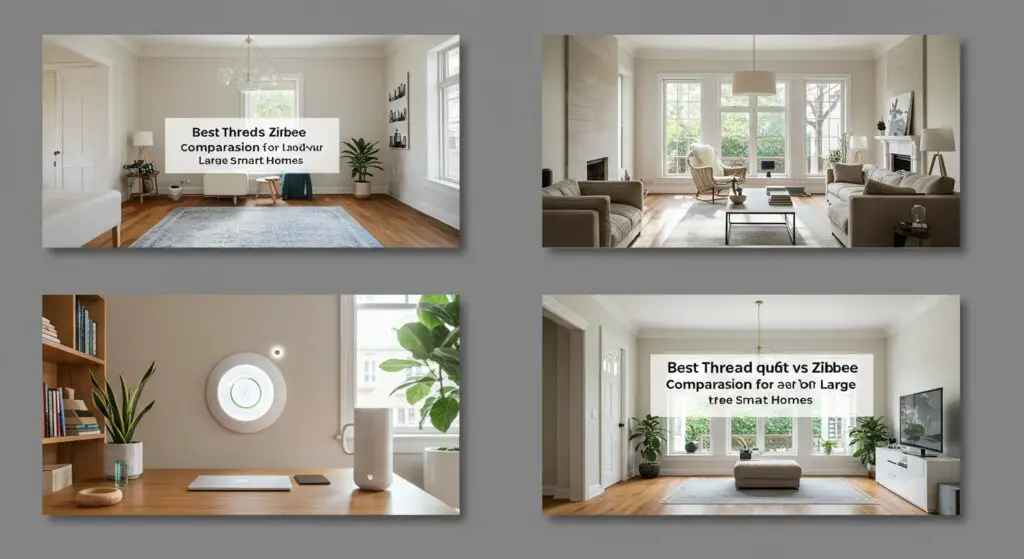Building a truly smart home, especially one spanning a significant area, presents a unique set of connectivity challenges. The seamless operation of hundreds of devices relies heavily on the underlying communication protocol. While many options exist, two contenders frequently emerge in the discussion of robust, scalable networks: Thread and Zigbee. Understanding their nuanced differences becomes paramount when designing a large smart home system.
This comprehensive comparison delves into the core functionalities, strengths, and limitations of Thread versus Zigbee. We will explore how each protocol performs under the demands of extensive environments. Our goal is to equip you with the knowledge needed to make an informed decision, ensuring your smart home network is both reliable and future-proof.

Understanding Smart Home Network Protocols
At the heart of every connected device lies a communication protocol. These digital languages allow your smart lights, thermostats, and sensors to talk to each other and to your central control system. For large homes, the choice of protocol significantly impacts performance, stability, and the overall user experience.
What is Zigbee?
Zigbee has long been a dominant force in the smart home landscape. It is a well-established, open global standard for low-power, low-data-rate wireless mesh networks. Devices using Zigbee technology form a self-healing mesh, where each powered device can act as a repeater, extending the network’s reach. This architecture makes Zigbee network smart home setups inherently resilient.
Historically, Zigbee networks require a dedicated hub or bridge to connect to your home’s Wi-Fi network and the internet. This hub translates Zigbee commands into something your router understands. Its widespread adoption means a vast ecosystem of compatible devices is available, offering a mature and proven solution for many smart home applications.
What is Thread?
Thread technology smart home networks represent a newer, IP-based protocol. Unlike Zigbee, Thread is built on internet protocols (IPv6), meaning every Thread device can potentially have its own IP address. This foundational difference eliminates the traditional need for a central hub to connect to the internet, although a Thread Border Router is required to bridge the Thread network to your Wi-Fi or Ethernet. This Border Router acts as a gateway, allowing devices on the Thread network to communicate with devices outside of it.
Thread is designed from the ground up to be highly reliable, secure, and energy-efficient. Its IP-based nature is a key enabler for Matter, the new smart home connectivity standard, promising unparalleled interoperability. This makes the Thread network smart home a compelling choice for those looking forward.
Core Differences: Thread vs Zigbee for Large Homes
When evaluating Thread vs Zigbee for large homes, several critical performance metrics come into play. These factors directly influence the efficiency and responsiveness of your expansive smart home system.
Network Architecture and Scalability
Both Thread and Zigbee utilize mesh network topologies. In a mesh network, devices communicate not just with a central hub, but also with each other. This allows signals to hop from device to device, extending the overall range and creating redundant communication paths. However, their implementations differ.
Zigbee networks can support a substantial number of devices, typically hundreds, depending on the hub’s capacity. The network’s robustness relies on having enough mains-powered devices to act as repeaters. Thread, being IP-based, theoretically supports an even greater number of devices, potentially thousands. Its architecture is inherently designed for large-scale deployments, making it a strong contender for large smart home network solutions.
Range and Signal Penetration
The physical reach of your smart home network is crucial in a large property. Thread vs Zigbee range capabilities are comparable on paper, typically around 30-60 feet indoors per hop. However, the effectiveness of this range is heavily influenced by building materials and interference.
Due to its IP foundation, Thread often exhibits better routing efficiency, potentially leading to more reliable signal propagation through walls and floors. A Thread network’s ability to seamlessly re-route data packets through any available path enhances its overall reach and penetration in complex, multi-story large homes. This gives Thread a slight edge in challenging environments.
Reliability and Self-Healing
Thread vs Zigbee reliability is a key differentiator. Both protocols boast self-healing mesh capabilities, meaning if one device goes offline, the network automatically finds an alternative path for data. This resilience is vital for consistent smart home operation.
Thread’s architecture, with its IP-based routing and robust security features, is engineered for enterprise-grade reliability. It’s designed to be more resilient to network disruptions and interference. Zigbee is also very reliable, but its reliance on a central hub can sometimes introduce a single point of failure if that hub malfunctions. Thread’s distributed border router concept offers a more decentralized, and arguably, more robust, solution for maintaining constant connectivity.
Latency and Responsiveness
The speed at which your commands are executed is known as latency. In a smart home, low latency means instant light switching or quick sensor responses. Thread vs Zigbee latency benchmarks show both are generally very fast, especially compared to Wi-Fi devices which can introduce more delay.
Thread’s streamlined, IP-based routing can sometimes offer marginally lower latency, particularly in very large networks with many hops. This translates to a more immediate and satisfying user experience. When you press a smart switch, you want an instant reaction, and both protocols deliver, but Thread might be slightly snappier in complex scenarios.
Power Consumption
Many smart home devices, such as door sensors or motion detectors, are battery-powered. Therefore, Thread vs Zigbee power consumption is a significant factor. Both protocols are designed for ultra-low power operation, allowing battery-powered devices to last for years on a single set of batteries.
Thread was specifically engineered with power efficiency in mind for battery-operated devices (known as End Devices). Its sleep modes and efficient data transmission mechanisms are optimized to conserve power. Zigbee also excels in this area, having a long history of powering battery devices. For practical purposes, both offer excellent battery life, making them suitable for widespread deployment without constant battery changes.
Security Protocols
Security is paramount in any connected home. Both Thread and Zigbee employ robust encryption standards to protect your data from unauthorized access. Zigbee uses AES 128-bit encryption, a strong industry standard. Thread also utilizes AES 128-bit encryption, but its IP-based nature allows for more advanced, standard internet security protocols to be layered on top, potentially offering a more comprehensive security posture.
Thread’s design inherently supports secure commissioning and communication, making it difficult for unauthorized devices to join the network. This enhanced security makes both protocols viable, but Thread offers a slightly more modern and adaptable security framework.
The Matter Factor: Redefining Connectivity

The emergence of Matter is reshaping the smart home landscape. This new connectivity standard aims to unify smart home devices across different ecosystems, making setup easier and improving interoperability. Its impact on the Zigbee vs Thread comparison is profound.
Matter over Thread: A Game Changer?
Matter over Thread is a powerful combination. Because Thread is IP-based, it serves as an ideal transport layer for Matter. This means Matter-certified devices can communicate directly over a Thread network without needing a proprietary hub. This significantly simplifies device setup and management, as all Matter-over-Thread devices can speak the same language and integrate seamlessly into ecosystems like HomeKit, Google Home, and Amazon Alexa.
This synergy is a major step towards true plug-and-play smart home experiences. It promises to reduce fragmentation and enhance the user experience, making a Matter-over-Thread foundation very attractive for future-proofing your large smart home.
How Matter Impacts Zigbee
While Matter primarily leverages Thread for IP-based communication, it doesn’t render Zigbee obsolete. Many existing Zigbee devices can still be integrated into a Matter ecosystem through a Matter bridge or hub. This bridge translates Zigbee commands into Matter commands, allowing older devices to participate in the unified system.
The future of smart home protocols will likely see a coexistence. New devices will increasingly adopt Matter over Thread, but Zigbee will continue to be relevant, especially for existing installations and specific low-power applications. The smart home connectivity standards are evolving, and both protocols have a place.
Practical Considerations for Large Smart Homes
Beyond the technical specifications, real-world factors influence the best protocol for large smart home deployments.
Ecosystem Compatibility
Your choice of smart home ecosystem (e.g., Apple HomeKit, Samsung SmartThings, Amazon Alexa, Google Home) plays a significant role. HomeKit Thread vs Zigbee compatibility has evolved. Apple has embraced Thread, making it a cornerstone for HomeKit’s future. Many new HomeKit devices are Thread-enabled.
SmartThings Thread vs Zigbee integration is also strong. SmartThings has long supported Zigbee and is now actively integrating Thread and Matter. Most major platforms are moving towards supporting Matter, which inherently benefits Thread. Ensure your chosen protocol aligns with your preferred ecosystem for seamless control.
Device Availability and Cost
Zigbee has a mature and extensive device ecosystem. You’ll find a vast array of affordable Zigbee devices, from sensors to light bulbs, readily available. This broad selection makes it easy to populate a large smart home.
Thread’s device ecosystem is rapidly expanding, driven by Matter. While the selection is growing, it’s still smaller than Zigbee’s. However, as Matter gains traction, more Thread-enabled devices will hit the market, potentially closing the gap in availability and price over time. For a large smart home, device cost can add up quickly, so this is a practical consideration.
Installation and Setup Complexity
Setting up a Zigbee network typically involves pairing devices with a central hub. This process is generally straightforward. For a large home, you might need to strategically place repeaters to ensure full coverage.
Thread setup is often simpler, especially with Matter. Devices can be onboarded directly into your ecosystem with a simple scan, and the network forms automatically. The concept of a Thread Border Router is crucial here, as it acts as the bridge to your Wi-Fi. Many modern smart home hubs, Wi-Fi routers, and even Apple HomePods or Google Nest Hubs can function as Thread Border Routers, simplifying the setup for a Thread network smart home.
Future-Proofing Your Smart Home
The future of smart home protocols is undeniably leaning towards IP-based solutions like Thread, especially with the widespread adoption of Matter. Investing in Thread technology smart home devices now positions your large home to take full advantage of future interoperability and innovations.
While Zigbee will remain viable for years, its long-term trajectory might involve more reliance on bridges to integrate with newer Matter-enabled systems. For a significant investment like a large smart home, considering the longevity and adaptability of your chosen protocol is a very wise move. Smart home connectivity standards are continually evolving, and staying ahead of the curve is beneficial.
Which Protocol Reigns Supreme for Your Large Home?

The best protocol for large smart home environments isn’t a one-size-fits-all answer. Both Thread vs Zigbee smart home solutions offer compelling advantages. Your ultimate choice depends on your specific priorities, existing equipment, and vision for the future.
- Choose Thread if: You are building a new large smart home from scratch, prioritize future-proofing with Matter, desire a highly robust and decentralized network, or want potentially lower latency for critical automations. Thread’s IP-based nature and inherent Matter compatibility make it exceptionally appealing for long-term scalability and interoperability.
- Choose Zigbee if: You already have a significant investment in Zigbee devices, prefer a mature ecosystem with a vast array of affordable devices, or are comfortable with a hub-centric network. Zigbee remains a highly reliable and efficient protocol, particularly when you have many powered devices acting as repeaters.
- Consider a Hybrid Approach if: You want to leverage the strengths of both. Many modern smart home hubs support both Zigbee and Thread, allowing you to integrate devices from both ecosystems. This provides flexibility and the ability to choose the best device for each specific need within your large home.
Conclusion
The Thread vs Zigbee smart home debate for large residences highlights two excellent, low-power mesh networking protocols. Both offer the scalability and reliability necessary for extensive smart home deployments. Zigbee, with its established presence and vast device ecosystem, remains a strong, proven choice. Thread, with its modern IP-based architecture and deep integration with Matter, represents the cutting edge of smart home connectivity standards.
For those embarking on a new large smart home project or looking to upgrade significantly, leaning towards Thread and Matter over Thread vs Zigbee offers a compelling vision of seamless, future-proof interoperability. However, Zigbee continues to be a robust and cost-effective solution for many applications. Ultimately, evaluating your specific needs for range, reliability, latency, power consumption, and ecosystem compatibility will guide you to the best protocol for your unique large smart home network solutions. Make an informed decision to ensure your smart home operates flawlessly for years to come.